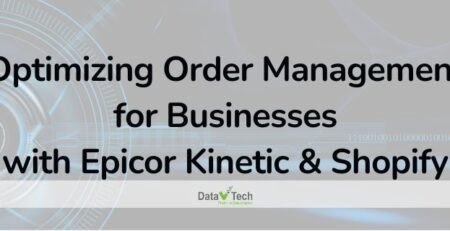Integrating Shopify, a popular e-commerce platform, into Epicor Kinetic, a robust ERP system, can significantly streamline your business operations. You can effectively manage orders, products, inventory, and customer information by synchronizing data between the two systems. This article provides a step-by-step guide on integrating Shopify into Epicor Kinetic, empowering your business with seamless connectivity and efficiency.
Understand Your Requirements
Identify the specific data and functionality you need to synchronize between Shopify and Epicor Kinetic. This may include orders, products, inventory, customer information, etc. A clear understanding of your requirements will guide you throughout the integration process.
Explore Available Options
Check if Epicor Kinetic offers built-in integration capabilities or existing third-party integrations are available. Look for Shopify-specific apps or connectors that simplify and accelerate the integration process. Taking advantage of pre-built solutions can save you time and resources.
Review the Shopify API Documentation
Familiarize yourself with Shopify’s API documentation, which can be found at developers.shopify.com/docs. This comprehensive resource will provide valuable insights on how to interact with the Shopify platform programmatically. Understanding the API will enable you to retrieve and update data seamlessly.
Design Your Integration Architecture
Determine how you want to connect Shopify and Epicor Kinetic. You have two main options: building a custom integration using your servers or leveraging a cloud-based integration platform such as Zapier, Tray.io, or Workato. These platforms offer pre-built connectors for Shopify and Epicor Kinetic, simplifying the integration process.
Develop the Integration
To build a custom integration, you will need to use programming languages like Python, Java, or .NET to interact with the Shopify and Epicor Kinetic APIs. Authenticate with Shopify using API keys, access tokens, or OAuth, and retrieve or update data as needed. Refer to Epicor Kinetic’s API documentation or SDK for guidance on interacting with its services.
Synchronize Data
Determine the frequency and direction of data synchronization between Shopify and Epicor Kinetic. For example, you may need to sync orders from Shopify to Epicor Kinetic and update inventory levels from Epicor Kinetic to Shopify. Establish a reliable process to ensure consistent and accurate data flow between the two systems.
Test and Debug
Thoroughly test your integration to verify that Shopify and Epicor Kinetic data is synchronized. Validate data consistency and handle any error cases that may arise during the integration process. Rigorous testing ensures a smooth and reliable integration.
Monitor and Maintain
Once your integration is operational, establish monitoring and error-handling mechanisms to identify and resolve any issues that may occur. Stay updated with the latest changes to the Shopify and Epicor Kinetic APIs, as updates may require adjustments to your integration. Regular maintenance ensures the continued efficiency of your integration.
Integrating Shopify into Epicor Kinetic can bring immense benefits to your business by streamlining your operations and enhancing efficiency. Following the steps outlined in this guide, you’ll be well-equipped to embark on a successful integration journey. Remember to consult the documentation and support resources provided by Shopify and Epicor Kinetic for more specific guidance tailored to your unique requirements. Empower your business with a seamless connection between Shopify and Epicor Kinetic today!











